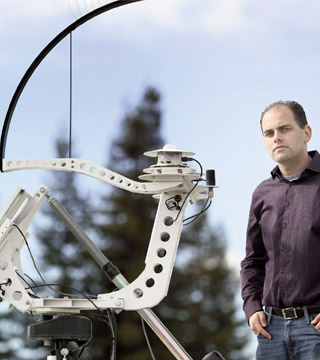
Matt Lave (6112) uses pyranometers like these to measure the amount of irradiance, or available sunlight. There are four round pyranometers, capped by small glass domes, on this device. The work by Matt and Josh Stein (6112) shows that the variability of a point sensor is larger than the variability of a PV power plant. (Photo by Dino Vournas)
The sun’s abundant energy presents a clean, affordable, and renewable way to keep the power on. Systems are relatively easy to install and begin working immediately. They are virtually maintenance-free and can run unassisted for decades.
But clouds are dimming industry growth: What happens when they cover part of a solar photovoltaic (PV) array and cause a dip in output, how big is the dip, and how can a utility company compensate for it?
Matt Lave (6112) has been working to understand that drawback and determine just how much clouds can affect solar power plant output.
Typically, sunlight is measured using a single irradiance point sensor, which correlates nicely to a single PV panel. But that doesn’t translate to a large PV power plant.
“If a cloud passes over, it might cover one panel, but other panels aren’t affected,” Matt says. “So if you use the single point sensor to represent the variability of the whole power plant, you will significantly overestimate the variability.”
To get a more accurate picture of how clouds affect PV power plants, Matt developed a Wavelet Variability Model, or WVM, to use data from a point sensor and scale it up to accurately represent the entire power plant. The WVM uses measurements from an irradiance point sensor, the power plant footprint — or the arrangement and number of PV modules in the plant — and the daily local cloud speed to estimate the output of a power plant.
In many cases, output measurements from the power plant aren’t available, but point sensor data is, so the WVM is useful for estimating how much energy must be stored to make up for cloud-caused fluctuations.
The variability is a concern for grid operators as unanticipated changes in PV plant output can strain the electric grid. At short timescales, measured in seconds, sharp changes in power output from a PV power plant can cause local voltage to flicker. At longer timescales, measured in minutes, producing less PV power than expected produces balancing and frequency issues, where load can exceed generation. Backup systems (such as battery storage) to mitigate the variability can substantially add to the cost of a PV power plant.
He points to Puerto Rico, where changes in power output are required to be less than 10 percent per minute. “With this tool, you can estimate how often you’ll exceed that limit, and determine how to mitigate those effects.”
Matt and Josh Stein (6112) teamed with researchers from University of California at San Diego, where Matt did graduate work, and recently published a book chapter in Solar Energy Forecasting and Resource Assessment. The chapter, “Quantifying and Simulating Solar-Plant Variability using Irradiance Data,” offers metrics to characterize and simulate the variability of solar power plant output.
This work supports the DOE SunShot vision of reducing solar costs and greatly increasing how much solar energy goes to the electric grid. By helping grid operators solve variable short-term power generation problems, Matt says utilities will be more likely to increase their solar energy portfolios.
“Essentially, there has been something of a problem in the industry with people assuming that the point sensor’s variability represents their whole plant’s variability, and significantly overestimating the problems that would be caused by connecting PV to the electric grid. That’s something I hope to help people understand. It’s not going to be as big of a problem as it would seem from an irradiance point sensor,” Matt says.